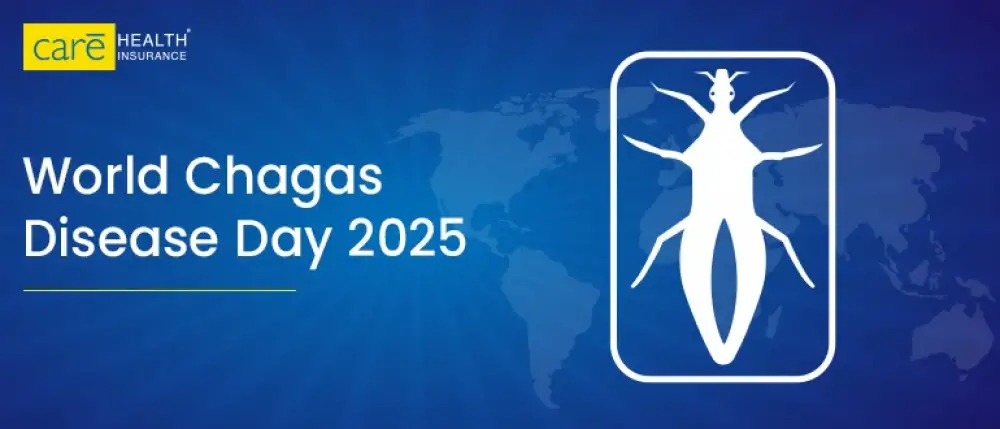Subscribe to get weekly insights
Always stay up to date with our newest articles sent direct to your inbox
Published on 7 Apr, 2025
Updated on 7 Apr, 2025
9 Views
5 min Read

Written by Mudit Handa
Reviewed by Akhil Pillai
0Like
Be the First to Like
In today’s era, the most significant challenges to urban development are the lack of sanitation and proper hygiene, which leads to the spreading of various vector-borne diseases in cities. According to WHO, vector-borne diseases account for over 17% of all contagious diseases, causing more than 700,000 deaths annually. One such dreadful disease is Chagas Disease, which affects 6 to 7 million people worldwide and results in over 12,000 deaths.
World Chagas Disease Day is observed on April 14th every year to raise awareness about Chagas disease and the challenges faced by those affected.
This article will illuminate the significance of World Chagas Disease Day and the effective ways to combat this disease.
Chagas disease, also known as American trypanosomiasis, is primarily spread by the protozoa through the bite of a parasite “Trypanosoma cruzi”. However, it can also spread via other transmission routes listed below:
These are various ways Chagas disease can be transmitted. As a volunteer, you must educate the masses about all these causes in detail and suggest ways to prevent them.
Chagas disease has acute and chronic phases. The symptoms for each phase are given below:
Acute Phase: Normally, the disease occurs shortly after infection and typically lasts a few weeks or months. Symptoms can be mild or absent; many people may not realise they are infected with Chagas disease.
Chronic Phase: The disease can persist for years or even decades after the initial infection. Many people with chronic Chagas disease never develop symptoms. However, some may experience severe complications–
Note: Not everyone infected with the parasite that causes Chagas disease will develop chronic symptoms. However, if left untreated, the disease can lead to serious and potentially life-threatening complications.
World Chagas Disease Day aims to increase the visibility of the disease, promote access to diagnosis and treatment, encourage prevention and control measures, and support research and development of new tools. Accordingly, the day focuses on fulfilling the following objectives:
World Chagas Disease Day was first observed in 2020. The first case of this disease was diagnosed by Brazilian doctor Carlos Ribeiro Justiniano Chagas on April 14, 1909. Hence, the disease was named in his honour. At the 72nd session of the World Health Assembly on May 28, 2019, World Chagas Disease Day was declared a global health awareness day.
The official theme for World Chagas Disease Day 2025 has not been announced yet. However, it will likely emphasise raising awareness, promoting early diagnosis and treatment, and supporting transmission interruption. Last year, the theme was “Tackling Chagas disease: detect early and care for life”, emphasising the significance of early disease detection and comprehensive follow-up care.
The primary objective of World Chagas Disease Day is to raise awareness about Chagas disease and promote prevention and control measures. Therefore, you can participate in this special day by engaging in the following activities:
These are some impactful ways to take a lead role in raising awareness regarding the perils of Chagas disease, which acts as a silent killer.
Over the past five years, World Chagas Disease Day has had several key impacts globally:
Chagas disease is treatable, and early treatment is crucial for the best outcome. Whether it is considered ‘curable’ depends on the stage of the infection.
Therefore, while the disease is highly treatable and often curable in the acute phase, managing symptoms and preventing progression in the chronic phase is critical. Early diagnosis and treatment are key to improving outcomes. It is essential to take only prescribed drugs and avoid over-the-counter medications.
In addition to access to quality healthcare and medication, adequate health coverage is crucial to cover all the expenses associated with curing this disease.
Chagas disease can be very severe, and its symptoms may last for years. Treatment for such a disease can not only consume crucial years of your life but can also deplete your entire savings. Therefore, it is essential to have a comprehensive critical illness insurance policy that covers all the expenses related to treating a critical illness. Additionally, you should look for an organ donor cover benefit that covers the organ replacement surgery cost for the donor when choosing the health insurance plan.
>> Also Read: World Health Day
Disclaimer: Plan features, benefits, coverage, and claims underwriting are subject to policy terms and conditions. Kindly refer to the brochure, sales prospectus, and policy documents carefully.
Be the First to Like
शुगर कंट्रोल कैसे करे? जानें, डायबिटीज में क्या खाना चाहिए Care Health Insurance in Health & Wellness
Thyroid : मामूली नहीं हैं महिलाओं में थायराइड होना, जानें इसके लक्षण और घरेलू उपचार Care Health Insurance in Diseases
हाई ब्लड प्रेशर को तुरंत कंट्रोल कैसे करें? देखें इसके उपाय Care Health Insurance in Diseases
प्लेटलेट्स की कमी के लक्षण, कारण और इलाज क्या है Care Health Insurance in Diseases
World Parkinson’s Day: Raising Hope for the Elderly Care Health Insurance in Awareness Days
World Bipolar Day 2025: Understanding Bipolar Disorder and Breaking Stigma Care Health Insurance in Health Insurance Articles
ट्यूबरक्लोसिस (टीबी) के लक्षण, कारण और इलाज Care Health Insurance in Awareness Days
World Water Day 2025: Raising Awareness About the Global Water Crisis Care Health Insurance in Awareness Days